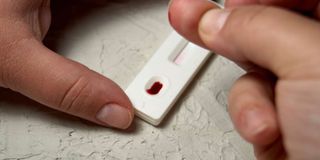New strategy gives HIV patients hope

A patient takes a sample for an HIV test. Researchers have found that they can “shock and kill” dormant HIV in a patient. PHOTO | FOTOSEARCH
Millions of people living with HIV can hope for a cure after scientists discovered a new mechanism which helps the immune system to detect and kill HIV in its hideout.
The researchers at Norwegian University of Science and Technology’s (NTNU) Centre of Molecular Inflammation Research found that they can “shock and kill” dormant HIV in a patient.
They learnt of a previously unidentified way in which the body’s immune system can detect and respond to HIV infection and which could help improve the chances of developing a cure. The researchers used cells from nine HIV patients and found that there was an undescribed immune response when HIV is destroyed in an endosome – found in cells.
“This may hold the key to allowing the shock-and-kill approach to work,” they said in their report. According to research, when HIV gets into the body, it infects the very cells that the body would use to combat it - the CD4 T helper cells. When these CD4 T cells are infected, they cannot fight dis- eases or infections because they are weakened. But then, a T helper cell may lack the receptor which is used by the HIV to attach itself on the white blood cell so as to infect it. This means that the virus cannot actively infect that cell. Instead, the virus can get trapped in a vesicle (sac) in the T cell, called an endosome, which kills it, says the report. The researchers found that when an endosome destroys the virus, some of the genetic material is exposed to the T cell which in turn activates a type of molecule called TLR8. The molecule, in turn, acti- vates the production of substances known as cytokines, which cause inflammation in the body.
“The inflammation caused by the cytokines helps to wake up T cells that had formally been dormant and that contain HIV genetic material. The T cell detects the virus and produces cytokines, and these cytokines act on cells that are properly infected with HIV and makes them produce more virus. The dormant T helper cells produce virus, and the T cells that were actively producing virus will produce more of it,” said a co-author of the study Markus Haug.
This means that the signal sent by the TLR8 and the cytokine-in- duced inflammation shock the HIV out of the dormant cells, where it can be destroyed. “If the virus that lies dormant in the cells could be smoked out into the open, the formally dormant virus could then be killed by the body’s immune system or drugs, and that would leave the patient HIV free and cured,” said Hany Meås, a post graduate doctor who also co-authored the report. According to him, the dormant virus needs to be activated for it to start replicating, to make the cell visible to the immune system.
“That is the current idea for a cure. We just need to activate cells that are hiding away so we can kill them, while we give medicine that protects cells from infection because there will be more virus produced,” he said. Human beings have adaptive im- mune system and innate immune system. While the T helper cells are part of the adaptive immune system and respond to specific infections over time, the TLR8 belong to the innate immune system which recognises and responds to “bits of viruses (or bacteria) that are com- mon across many di erent viruses (or bacteria)”. It was previously thought that these were two separate systems, but according to Meås the study shows that a receptor associated with the innate system actually exists and functions in the adaptive immune system. “Today we have treatment that can stop HIV from replicating itself and the T helper cells can come back,” he said. Unfortunately, the virus comes back when a patient stops taking antiretroviral drugs because HIV hides its genetic material inside dormant T cells and may wreak havoc in the patient.



